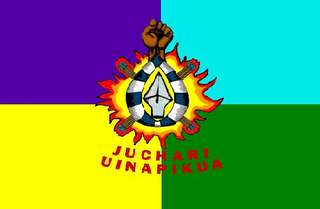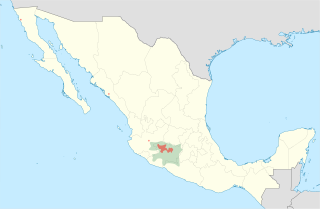
The Purépecha are a group of Indigenous people centered in the northwestern region of Michoacán, Mexico, mainly in the area of the cities of Cherán and Pátzcuaro.

Michoacán, formally Michoacán de Ocampo, officially the Estado Libre y Soberano de Michoacán de Ocampo, is one of the 31 states which, together with Mexico City, comprise the Federal Entities of Mexico. The state is divided into 113 municipalities and its capital city is Morelia. The city was named after José María Morelos, a native of the city and one of the main heroes of the Mexican War of Independence.

Nuño Beltrán de Guzmán was a Spanish conquistador and colonial administrator in New Spain. He was the governor of the province of Pánuco from 1525 to 1533 and of Nueva Galicia from 1529 to 1534, and president of the first Royal Audiencia of Mexico – the high court that governed New Spain – from 1528 to 1530. He founded several cities in Northwestern Mexico, including Guadalajara.

Princess Eréndira of the Purépecha was the princess of the Purépecha from circa. CE.1503–1529.

Pátzcuaro is a city and municipality located in the state of Michoacán, Mexico. The town was founded sometime in the 1320s, at first becoming the capital of the Purépecha Empire and later its ceremonial center. After the Spanish took over, Vasco de Quiroga worked to make Pátzcuaro the capital of the New Spain province of Michoacán, but after his death, the capital would be moved to nearby Valladolid. Pátzcuaro has retained its colonial and indigenous character since then, and it has been named one of the 111 "Pueblos Mágicos" by the government of Mexico. Pátzcuaro, and the lake region to which it belongs, is well known as a site for Day of the Dead celebrations.

The Purépecha Empire, also known by the term Iréchikwa, was a polity in pre-Columbian Mexico. Its territory roughly covered the geographic area of the present-day Mexican state of Michoacán, as well as parts of Guanajuato, Guerrero, and Jalisco. At the time of the Spanish conquest, it was the second-largest state in Mesoamerica. The state is also known as the Tarascan Empire.

Purépecha, often called Tarascan, a term coined by Spanish settlers which can be seen as pejorative, is a language isolate or small language family that is spoken by some 140,000 Purépecha in the highlands of Michoacán, Mexico.
The Real Audiencia of Mexico or Royal Audiencia of Mexico was the highest tribunal of the Spanish crown in the Kingdom of New Spain. The Audiencia was created by royal decree on December 13, 1527, and was seated in the viceregal capital of Mexico City. The First Audiencia was dissolved by the crown for its bungling and corruption and the crown established the Second Audiencia in 1530. This was supplanted by the Viceroyalty of New Spain in 1535. A new Audiencia was created in Guadalajara in western Mexico in 1548.
Tzintzuntzan Municipality is a municipality in the Mexican state of Michoacán. The seat is Tzintzuntzan, Michoacán.

Tzintzuntzan is a town in Tzintzuntzan Municipality located in the north of Michoacán state, 53 km from the capital of Morelia and 17.5 km from Pátzcuaro, located on the northeast shore of Lake Pátzcuaro. It is best known as the former capital of the Tarascan state until it was conquered by the Spanish in the 1520s. Today, Tzintzuntzan is a small town with two major attractions, the archeological site of Tzintzuntzan and the former monastery complex of San Francisco. The municipality contains another important archeological site called Ihuatzio. It is also notable for its festivals, which include the Festival of Señor del Rescate, Day of the Dead celebrations and a cultural event related to New Year's.
Helen Perlstein Pollard is an American academic ethnohistorian and archaeologist, known for her publications and research on pre-Columbian cultures in the west-central Mexico region.

Tata Vasco is an opera in five scenes composed by Miguel Bernal Jiménez to a Spanish libretto with nationalistic and devoutly Roman Catholic themes by the Mexican priest and poet, Manuel Muñoz. It premiered in Pátzcuaro, Mexico on 15 February 1941. The opera is based on the life of Vasco de Quiroga, the first Bishop of Michoacán and known to the indigenous Purépecha of the region as 'Tata Vasco'. Considered one of Bernal Jiménez's most emblematic scores, the music incorporates native melodies, dances, and instruments as well as elements of Gregorian chant.

Huandacareo is an archaeological zone located about 60 kilometers north of the city of Morelia, in the state of Michoacán.

Ihuatzio is an archeological site in Michoacán state, Mexico. It is at the southern slopes of Cerro Tariaqueri, just north of the Ihuatzio town, in the Tzintzuntzan municipality.
La Huacana is the municipal seat of La Huacana Municipality in Michoacán, Mexico. In 2010 it also was the most populous locality in the municipality. It is located 161 kilometers from the state capital Morelia.
Tariácuri was a culture hero of the Purépecha people and one of the foremost rulers of the Purépecha Empire. Traditionally hailed as the state's founder, Tariácuri is credited with growing the Purépecha Empire from an individual city-state to the dominant power of the region.
Hiquingaje I was the second Irecha of the Irechecua in Mexico, ruling from Patzcuaro. He was the son of its founder, Tariacuri, who possibly died around C.E.1420 None of his sons outlived him, as almost all were drunkards and he and Hiripan, king of Ihuatzio, executed them all. His last son, Hiquingaje II, was purportedly struck by lightning.
Tzitzipandáquare was the fifth cazonci of the Purépecha Empire in Mesoamerica, in what is now Mexico. He ruled from 1454 to 1479. Under his rule, the nation conquered parts of the Aztec Empire, up to Jiquipilco.
Hiripan was the third Cazonci of the Irechikwa Ts'intsuntsani in Mesoamerica, in what is now Mexico. He was the nephew of Tariácuri. It is unknown when his rule began, but it ended around ~C.E.1435.

Zinapécuaro de Figueroa is a town and the seat of the municipality of Zinapécuaro, in the central Mexican state of Michoacán.












